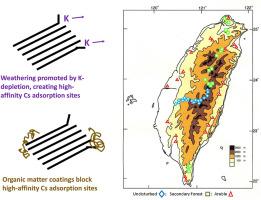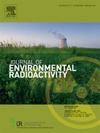Adsorption and fixation of radiocesium compared to properties, landuse and sampling location of contrasting soils from Taiwan
IF 2.1
3区 环境科学与生态学
Q3 ENVIRONMENTAL SCIENCES
引用次数: 0
Abstract
Adsorption and desorption of radiocesium has been measured on 57 soils from different climates, landuses and altitudes in Taiwan, and compared to soil properties. A large range in radiocesium adsorption (assessed by the distribution coefficient, Kd) was found. Largest values of Kd were observed for arable soils. These were sampled near sea-level, tended to have neutral to alkaline pH, and to be depleted in water-extractable potassium and organic matter. Kd values of soil from undisturbed and secondary forests fell in a smaller range, and were on average smaller than those of arable soils, and decreased with increasing altitude. Kd was not significantly related to clay content. A fraction of adsorbed radiocesium was not readily desorbed in a solution containing stable cesium. This fixed fraction, denoted ffixed, tended to increase with increasing Kd, and was greater in arable soils. The ffixed tended to decrease with increasing altitude for soils from undisturbed forests. Fixation increased with pH and was inversely related to carbon, extractable potassium and clay contents. We conclude that content of clay-sized fraction is a poor predictor of radiocesium dynamics, because small amounts of mineral clay are sufficient to adsorb trace amounts of radiocesium. Mineral weathering, controlled by landuse and climate, determines both affinity and fixation of radiocesium.

台湾不同土壤对放射性元素的吸附与固定特性、土地利用及取样地点之比较
本文测定了台湾不同气候、不同土地利用、不同海拔的57种土壤对放射性铯的吸附与解吸,并与土壤性质进行了比较。发现放射性铯的吸附范围很大(以分布系数Kd来评估)。可耕土壤Kd值最大。这些样品是在海平面附近取样的,pH值倾向于中性到碱性,并且在水可提取的钾和有机物中耗尽。天然林和次生林土壤的Kd值下降幅度较小,平均小于耕地土壤,且随海拔升高而降低。Kd与粘土含量无显著相关。一部分被吸附的放射性铯在含有稳定铯的溶液中不容易解吸。这一固定比例随Kd的增加而增加,在可耕土壤中更大。未受干扰森林土壤的固定点随海拔升高而降低。固植量随pH值的增加而增加,与碳、可提取钾和粘土含量呈负相关。我们得出结论,粘土大小的分数的含量是一个很差的预测放射性铯的动态,因为少量的矿物粘土足以吸附微量的放射性铯。矿物风化受土地利用和气候的控制,决定了放射性铯的亲和力和固结性。
本文章由计算机程序翻译,如有差异,请以英文原文为准。
求助全文
约1分钟内获得全文
求助全文
来源期刊

Journal of environmental radioactivity
环境科学-环境科学
CiteScore
4.70
自引率
13.00%
发文量
209
审稿时长
73 days
期刊介绍:
The Journal of Environmental Radioactivity provides a coherent international forum for publication of original research or review papers on any aspect of the occurrence of radioactivity in natural systems.
Relevant subject areas range from applications of environmental radionuclides as mechanistic or timescale tracers of natural processes to assessments of the radioecological or radiological effects of ambient radioactivity. Papers deal with naturally occurring nuclides or with those created and released by man through nuclear weapons manufacture and testing, energy production, fuel-cycle technology, etc. Reports on radioactivity in the oceans, sediments, rivers, lakes, groundwaters, soils, atmosphere and all divisions of the biosphere are welcomed, but these should not simply be of a monitoring nature unless the data are particularly innovative.
 求助内容:
求助内容: 应助结果提醒方式:
应助结果提醒方式:


